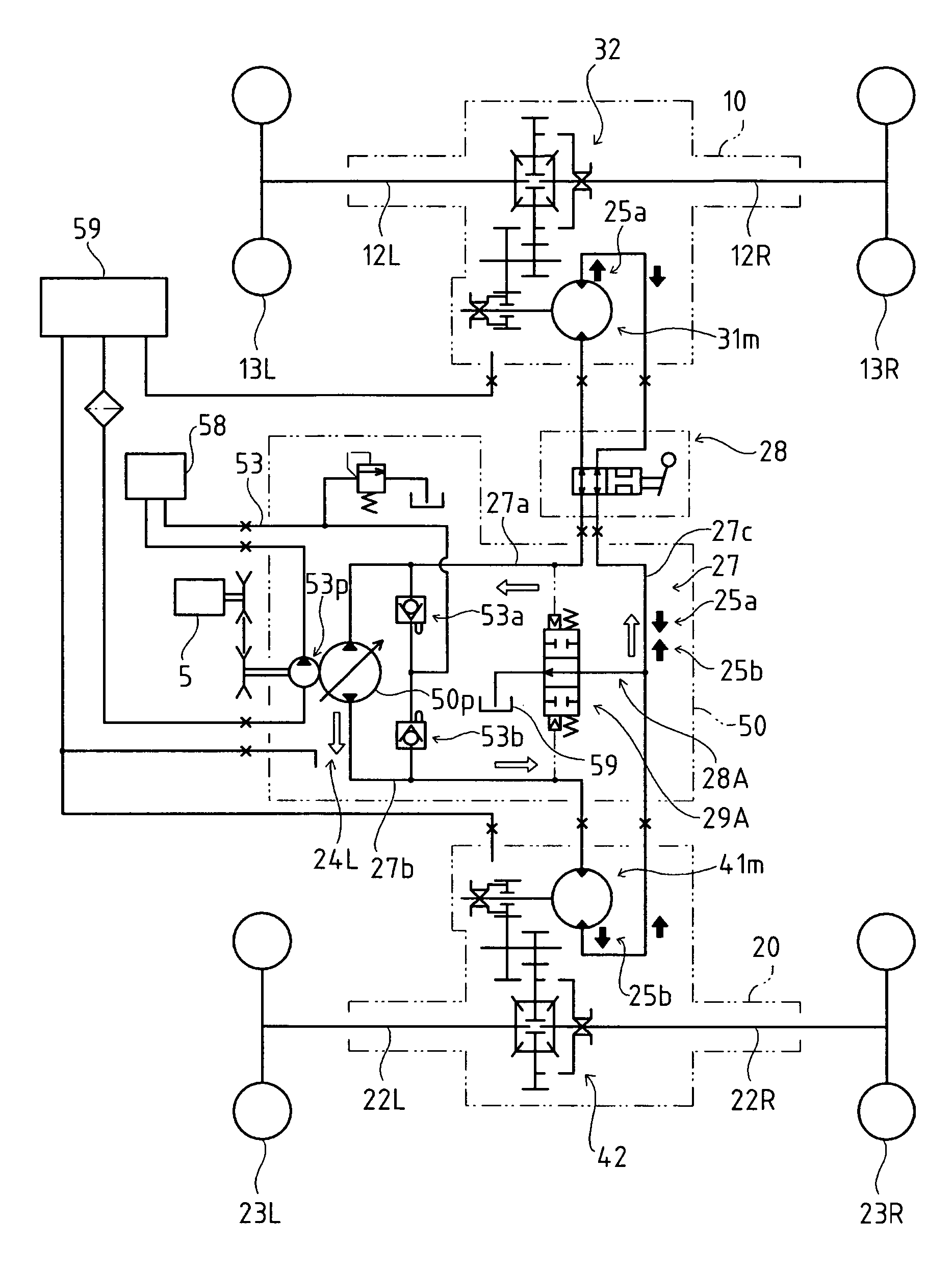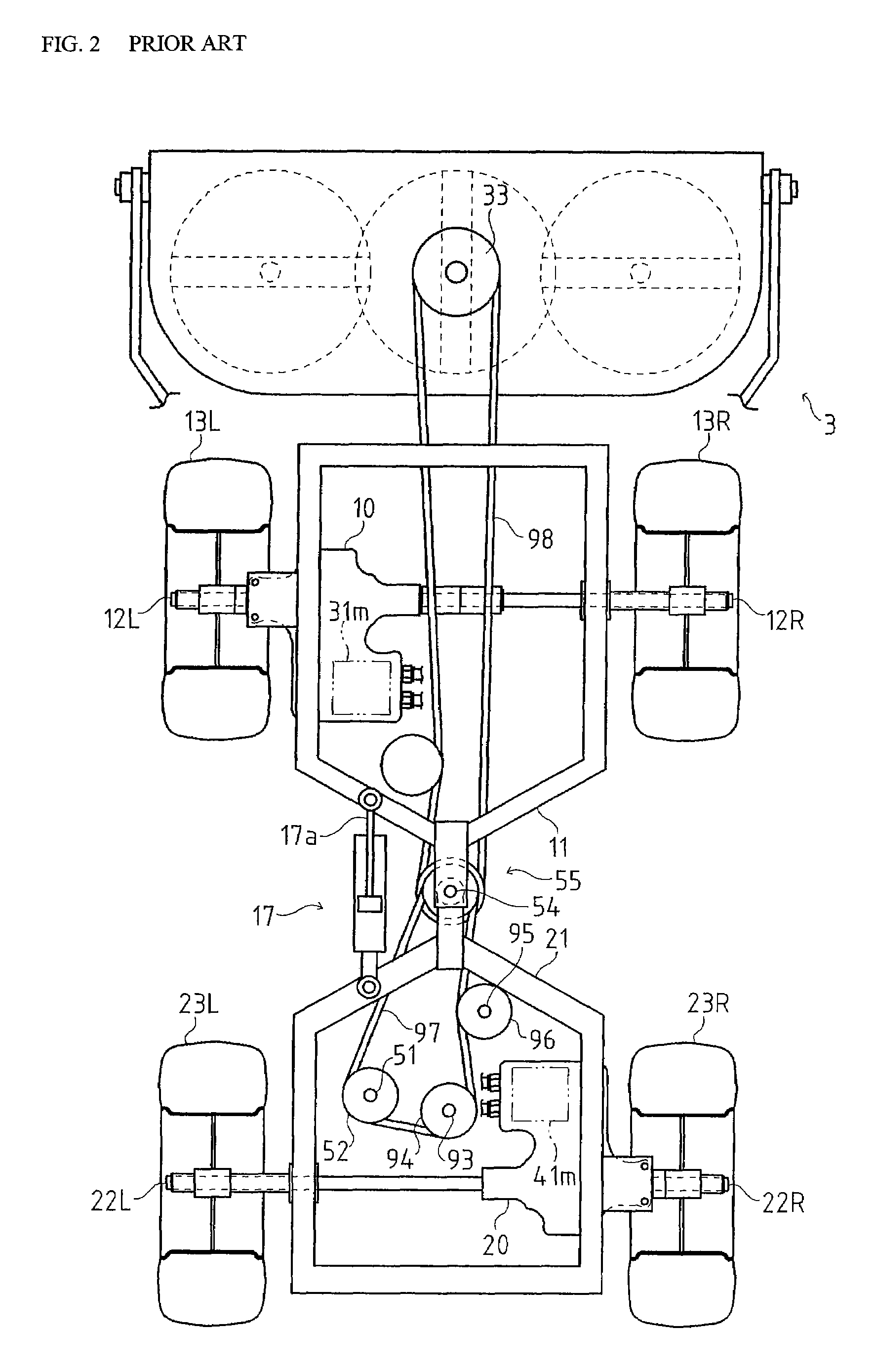Hydraulic four-wheel driving articulated vehicle
a four-wheel drive, hydraulic technology, applied in the direction of transportation and packaging, mechanical equipment, trailer steering, etc., can solve the problems that the stationary steering of the vehicle cannot be smoothly performed, and the conventional hydraulic four-wheel drive articulated vehicle cannot be smoothly steered, so as to achieve smooth steering
- Summary
- Abstract
- Description
- Claims
- Application Information
AI Technical Summary
Benefits of technology
Problems solved by technology
Method used
Image
Examples
second embodiment
[0069]The hydraulic circuit 27 of FIG. 8 is provided with alternative suitable pressure control means corresponding to the stationary steering operation according to a The pressure control means includes a pressure control valve 29B. The pressure control valve 29B, when being opened, collects the excessive oil from the passages 27a and 27b through respective orifices 35a and 35b, and sends it to the passage 27c (during the stationary steering operation, the hydraulic pressure in the passage 27c is lower than that in the passages 27a and 27b) through a relief passage 28B.
[0070]The pressure control valve 29B is a hydraulic pilot pressure valve having opposite pilot operation portions for receiving opposite pilot pressures extracted from the respective passages 27a and 27b.
[0071]Referring to FIG. 6, while the stationary steering is performed, the backward traveled distance of the front wheels 13L and 13R (the difference between the distances 115L and 115R) is equal to the forward tra...
third embodiment
[0075]The hydraulic circuit 27 of FIG. 9 is provided with alternative pressure control means corresponding to the stationary steering operation according to a The pressure control means includes a pressure control valve 36C, through which a relief passage 28C branches from the passage 27c to the oil tank 59. Alternatively, the relief passage 28C may be extended to the oil-charging passage 53.
[0076]The pressure control valve 36C is a pilot valve, which is closed when it receives a pilot pressure from a portion of the relief passage 28C in communication with the passage 27c. The pilot pressure is generated for closing the pressure control valve 36C when the hydraulic pump 50p discharges oil, so as to increase the hydraulic pressure in the passage 27c and the relief passage 28C, i.e., while the vehicle travels. When the hydraulic pump 50p (the vehicle) is stationary, oil is not circulated in the hydraulic circuit 27 and the hydraulic pressure in the passage 27c is reduced, thereby can...
fourth embodiment
[0078]The hydraulic circuit 27 of FIG. 10 is provided with alternative pressure control means corresponding to the stationary steering operation according to a The pressure control means includes a pressure control valve 36D. The pressure control valve 36D, when being opened, collects the excessive oil from the passages 27a and 27b through respective check valves 37a and 37b, and sends it to the passage 27c (during the stationary steering operation, the hydraulic pressure in the passage 27c is lower than that in the passages 27a and 27b) through a relief passage 28D.
[0079]The pressure control valve 36D is a pilot valve, which is closed when it receives a pilot pressure from the passages 27a and 27b. The pilot pressure is generated for closing the pressure control valve 36D when the hydraulic pump 50p discharges oil, so as to increase the hydraulic pressure in the passage 27a or 27b, i.e., while the vehicle travels. When the hydraulic pump 50p (the vehicle) is stationary, oil is not...
PUM
 Login to View More
Login to View More Abstract
Description
Claims
Application Information
 Login to View More
Login to View More - R&D
- Intellectual Property
- Life Sciences
- Materials
- Tech Scout
- Unparalleled Data Quality
- Higher Quality Content
- 60% Fewer Hallucinations
Browse by: Latest US Patents, China's latest patents, Technical Efficacy Thesaurus, Application Domain, Technology Topic, Popular Technical Reports.
© 2025 PatSnap. All rights reserved.Legal|Privacy policy|Modern Slavery Act Transparency Statement|Sitemap|About US| Contact US: help@patsnap.com



